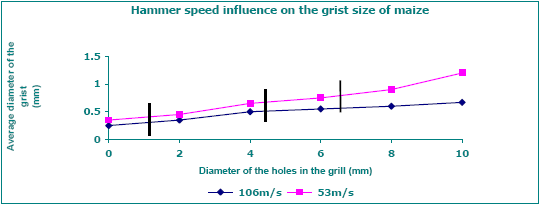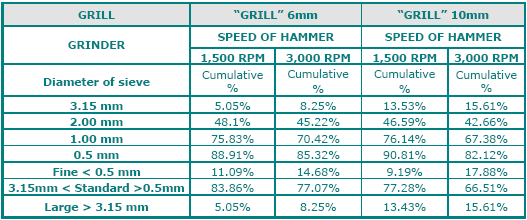



Mash or Pellet? The Question of Feed presentation, feed factory technology and manufacturing costs
By Jean-Jacques Trevidy, Hubbard Europe - This article evaluates the options of mashing or pelleting broiler feed, and like many choices the broiler producer has, the answer is dependant upon a number of factors (page 3/4).Feed presentation, feed factory technology & manufacturing costs:
|
|
| Contents/Navigation |
Feed presentation
The energy value of feed or raw materials may vary with type of feed presentation. These have been estimated for the following feed or cereal presentation:
- whole grain cereals added to complementary feed
- cereals or finished feed in mash form
- finished feed in pellet form.
Whole cereal grain is essentially wheat, barley, sorghum (milo) and to some extent whole maize when it is fed to grown birds (more than 30 days of age and / or over 1.2 Kg in bodyweight). Younger birds may be fed broken maize grain.
The energy values are stable, regardless of the presentation of the cereal.
Cereal AMEN (kcailkg DM)

In the above trial, wheat and maize are presented in three forms:
- ground for a mash type finished feed
- ground for a pellet type finished feed
- whole grain with a pellet type complementary feed.
Wheat energy value is stable regardless of the type of presentation. Whole grain maize shows a 3% lower value, but this may be due to more difficulty for ingestion of grain.
Mixing whole wheat together with feed, either at the farm or at the feed factory, is a frequent practice in Northern Europe. Most of the time, wheat is added at the farm according to broiler performance and sometimes directly at the feed factory, as the feed is loaded onto the feed delivery vehicle. Wheat addition averages between 15 % and 25 %, according to the broiler slaughter weight.
In the Philippines or in Bangladesh, a 50/50 mix of coarsely ground maize and complementary pelleted or mash feed gives very good results.
Cereals/ mash feed
Mash quality is assessed by the size and uniformity of its particles. A positive correlation between the increase in feed particle size and broiler growth has been demonstrated by several authors, including Nir on 0 to 3 week old chicks, and Lecierc on broilers between 22 to 39 days.
Good uniformity of particle size is essential because birds prefer bigger particles. Thus the dominant birds will quickly eat those bigger cereal particles, while the rest of the birds will eat the finer particles. However, particle selection seems to be balanced by the birds since the cereal/concentrate consumption ratio in free choice eating is very similar to that for the whole feed.
The improvement in performance with feed particle size and uniformity is explained by the lower energy output birds make when they ingest bigger particles. The number of pecks to eat one given feed amount is reduced when particle size increases.
Being grain eaters, birds have a digestive tract designed to quickly ingest large amounts of feed, that are stored in the crop to be 'hydrated" and 'acidified' by lactic acid secretion before going through the proventriculus. In the proventriculus, hydrochloric acid and pepsin and mucus secretions are increased when feed particle size increases. The gizzard carries out feed grinding, feed impregnation and predigestion of the feed by the secretions from the proventriculus, as well as the regulation of feed in-flow and out-flow. This will have an effect upon three digestive flows: from gizzard to proventriculus; from jejunum to duodenum; from rectum to caeca. The intestinal peristaltic motiiity slows down the feed flow, allows better absorption of the nutrients by the intestinal viol, and helps to stabiiise the intestinal flora.
Pelleted feed
The positive effects of pelleting are well documented: higher feed density, no feed ingredient separation, better bacteriological quality, easier ingestion, improved growth and FCR. However, these may vary according to the quality of the raw materials, and that of the grinding and pelleting processes.
The two main physical indicators of pellet quality are:
hardness - measured by pellet resistance to breaking when submitted to external pressure
durability - measured by the level of "fines" produced during transportation from the feed factory to the farm, and distribution in the feeding system at farm.
Broiler reaction to the above two quality criteria is not easy to assess. In many experiments where better results are obtained with pelleted feed, precise mash characteristics were not given. Indeed, pellets always produce better results when compared to the same fine mash as used to make a good pellet, even more so when the energy level is low. This confirms that the major effect of pelleting dwells in improvement of ingestion.
However, a high energy feed presented either as a coarse mash containing whole grain, or a medium quality pellet because of its fat content, will give very similar results in growth, FCR and fat deposit.
The effect of particle size on growth and consumption of broilers between 21 and 39 days

Broilers may also show high sensitivity to pellet hardness. A hard pellet may be eaten less readily than a softer one, the latter being more likely to yield more fine particles. Still, cereal whole grain ingestion remains easy!
Broiler performance at 42 & 56 days

One must be cautious in practice because field conditions are often different compared to experimental conditions. The positive effect of pelleting is essentially due to the improved ingestion. In reality:
pelleting improves results for low or medium energy feed, which is easy to pellet. The improvement becomes less conspicuous for high-energy feed that is more difficult to pellet and produces more fine particles throughout the transportation and distribution processes
when high-energy feed is presented as a coarse mash, or as free choice grain + concentrate, the difference between the results is not as significant as when compared to pellet. This may be the wiser choice to reduce the risk of metabolic diseases.
Feed factory technology
As shown above, a coarse and uniform mash feed is certainly a good solution for broiler production. Coarse mash that may even be used to produce a pellet is an important factor to regulate feed digestion. Feed particle size depends mainly upon grinding. Two types of grinder are available (cylinder grinder and hammer grinder).
Grinders with fluted cylinders are not designed for heavy production. They are more sensitive to deterioration by foreign bodies, but they are less power consuming and the feed produced is more uniform in particle size.

Grinders with hammers are more often used. Grinding is achieved both by contact between feed particles and the hammers and the abrasive effect of the grills, Thus grinding control depends upon two main factors: hammer peripheral speed, and grili mesh size and the percentage of holes. Hammer peripheral speed is a combination of grinder diameter and rotation speed. For one given raw material, the higher the hammer speed, the wider is the distribution range of the feed particles.
Example of calculation:
- rotation speed = 1,500 RPM (Rotations Per Minute)
- grinder diameter = 0.7 m
- peripheral hammer speed = 0.7 x 3.14 x (1,500/60) = 55m/s
If the grinder runs at 3,000 RPM, the speed is 110 m/s. For poultry feed, 55 m/s is the most frequently used speed. Grinders with variable speed allow adapting speed to the raw materials and to the targets for feed particle size.
Grinder grills: the two important criteria are mesh diameter (from 2 to 10 mm), and the percentage of holes in the grill (from 27 to 52 %). The higher these two values, the higher the average feed particle size and the feed particle size distribution range is.

Average grist size of maize (cumulative %) using standard grills

The dispersion of particle size increases with speed of hammer and size of the grill
The feed particle size and the average distribution range of the feed particle size must be regularly monitored. Excessive variation is a sign of hammer or grill wear.
When blades are worn, the distance between the blade and grill (normally 8mm) is increased. The peripheral feed particle layer therefore becomes thicker and particle ejection is slowed down. The abrasive effect at grill level is increased. Grinder yield diminishes and more fine particles are produced.
In the same manner, worn grills will tend to reject particles back to the grinder instead of letting them out.
For most poultry species, the relevant range for feed particle size is -0.5 to 2 mm. Under 0.5mm, particles are less readily ingested, but this size is essentially composed of vitamins and minerals. Above 2 mm, comprises mostly of the cereals, which may give rise to feed particle selection by the birds.
Grinders with variable speed improve the uniformity of particle size and diminish the amount of particles outside the desired range. Grinders with 55 m/s speed, together with post-grinding sifting to exclude those particles above 3 mm, give good results when working with larger diameter mesh grills to reduce the production of fine particles.
POST SIEVING AND RECYCLING

In hot climates, fine mash is not recommended because of its adverse effect on ingestion. Mash should be coarse. The concentrate part of the feed (premix, minerals and proteins) may be presented as a crumble to reduce the amount of fine particles. When this is possible, it is of real interest to give a crumbled starter feed, made from an initially coarse mash.
The % and cumulative % using standard sieves (AFNOR standards)

Manufacturing costs
Power consumption for grinding and pelleting processes, which represents nearly 80% of the total power requirements, is taken into account.
Average power consumption in French feed factories

Grinding
Power consumption varies with raw materials and particle size produced

Power consumption and material loss increase with moisture: + 1% moisture =+ 10% more power
Pelleting
This is the highest power consuming operation. Pelleting quality is not easy to assess. Pellet binding must have good adhesion to reduce the production of fine particles during transportation, storage and distribution, yet they must not be too hard in order to avoid possible drops in consumption (Nir). Maize based feed pelleting is more difficult than that of wheat based feed. Several techniques are used to improve pellet binding: finer grinding, the addition of high levels of steam, high temperature (80-85 oC), possible use of an expander, the level of compression (the compression rate of a dye is calculated by: length/diameter=20). These techniques significantly increase power consumption, yet do they provide real guarantees of improved broiler performance?

In reality, comparing mash and pellet on the basis of the same feed formula is often a biased exercise, as the mash should be finer to obtain a good pellet. To compare pellet with a coarser mash, taking into account the additional grinding and pelleting costs, is more relevant.
| Introduction | PREVIOUS: Genetics | Feed | NEXT: Housing |
Source: Hubbard Technical Bulletin - January 2005









